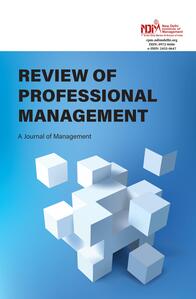
1 Department of Management, Mizoram University, Aizawl, Mizoram, India
Creative Commons Non Commercial CC BY-NC: This article is distributed under the terms of the Creative Commons Attribution-NonCommercial 4.0 License (http://www.creativecommons.org/licenses/by-nc/4.0/) which permits non-Commercial use, reproduction and distribution of the work without further permission provided the original work is attributed.
The human resource information system (HRIS) has played a significant role in promoting effective organisational learning, increased productivity, and sustainability during a time of demanding and evolving human resource management practices, as well as the development of information technology. This study combines a bibliometric analysis and a systematic literature review (SLR) to examine the topic. The systematic review was conducted in a methodical manner, involving the collection of available materials and their evaluation based on established criteria. The study focuses on articles published between 2001 and 2021, specifically from the Scopus database. To identify relevant articles, specific keywords such as ‘hris’, ‘hrms’, ‘human resource information system’ and ‘human resource management system’ were used. A total of 57 articles were included for further study based on predetermined inclusion and exclusion criteria. The purpose of this review-based work is to provide a qualitative understanding of the overall evolutionary trend, knowledge structure and literature gaps related to HRIS. It also suggests potential areas for future research, with a particular emphasis on the service sector, utilising open-source software. The findings highlight the benefits of implementing HRIS in the service sector and offer a comprehensive overview of the advancements and diversification of publications and research in this field. Additionally, the study provides scholars and practitioners with valuable insights to implement HRIS in various sustainable sectors.
Human resource information system, human resource, systematic literature review, bibliometric analysis, service sector
Introduction
The human resource information system (HRIS) is a concept that involves effectively managing human resource management (HRM) activities and applications through the use of information technology (IT) development and features (Kovach et al., 2002). HRIS has gained increasing importance in improving communication procedures (Volkmer, 1999). Essentially, HRIS can be defined as a technology-based system that acquires, stores, manipulates, analyses, retrieves and distributes information relevant to an organisation’s human resources. It aims to meet users’ information needs and enhance productivity (Tannenbaum, 1990). The nature of HRIS varies depending on the company’s size, being more informal in small firms and more structured in large enterprises (Lengnick-Hall & Moritz, 2003). The rapid advancement of information and communication technology (ICT) in the past two decades has accelerated the adoption and usage of electronic human resource management (e-HRM) (Strohmeier, 2007). The integration of technology in HR has greatly impacted HR management operations, involving executives, managers and employees (Mathis & Jackson, 2010). Previously, information systems were primarily used to standardise data, but recent advancements in HRIS have led to reduced administrative costs and the introduction of various new applications, thereby making HR roles less independent and empowering the entire HR department (Alleyne et al., 2007).
HRIS Implementation in Different Service Sectors
Kirishna and Meena (2010) recognised the key functional areas in which ICT is used for information management in higher education institutions. The current degree of utilisation in higher education institutions suggests clear incorporation of ICT being used for managerial or information-based administration. In the late 1990s, Ball (2001) conducted research revealing that 60% of Fortune 500 companies utilised HRIS to assist with their daily HRM tasks. It was found that organisations using HRIS gained a competitive advantage over those that did not (Kavanagh & Thite, 2009). Rawat (2008) further suggests that modern higher education institutions face a significant challenge of improving learning environments while simultaneously reducing administrative operational costs.
As a consequence, employing an HRIS at a university enables for the most efficient use of resources, as well as increased speed, interoperability, upgradeability, accessibility, data integrity, privacy and security. The organisational element is concerned with how supportive the organisation is of the employees involved in the adoption of new systems. The size of the company is a key factor in deciding whether or not to use HRIS (DeLone, 1981). Small and medium-sized enterprises encounter a difficult issue when it comes to adopting IT systems due to limited financial resources and high initial setup expenses (Dixon et al., 2002; Poon & Swatman, 1999).
Literature Review
The literature presents various analyses on the utilisation of HRIS, with two distinct extremes of usage, as noted by Ball (2001). Kovach and Cathcart (1999) and Kovach et al. (2002) suggest that HRIS data can be employed for administrative purposes to save time and money. Additionally, they argue that HRIS data has the potential for analytical decision support. Ngai and Wat (2006) have discussed several other relevant studies on the implementation of HRIS. For instance, Martinson (1994) conducted a comparative analysis of IT usage levels in Canada and Hong Kong, finding that HRIS was less frequently utilised in Hong Kong compared to Canada, while IT for HRM was more frequently used in Hong Kong than in Canada.
In a survey conducted by Ball (2001), the utilisation of HRIS in smaller businesses in the United Kingdom was examined, revealing that these businesses are less inclined to adopt HRIS. Similarly, Burbach and Dundon (2005) conducted a study in the Republic of Ireland, focusing on the strategic capabilities of HRIS in enhancing people management practices across 520 enterprises. They observed that large foreign-owned businesses are more likely than smaller Irish-owned businesses to utilise HRIS. They also revealed that HRIS systems are usually used for administrative decisions rather than strategic ones. Chugh (2014) studied the role of HRIS in an educational organisation. The author surveyed around 250 full-time employees and 400 casual employees suggesting HRIS may help to stay competitive and adaptable if an organisation use them in the right way, but HR without people is impossible to imagine. HR’s nature, as a result, is to be able to maintain a constant balance of people and technology in order to continue to assist and drive an organisation forward.
Troshani et al. (2011) conducted a study to identify the factors affecting the adoption of HRIS in public sector organisations, specifically focusing on qualitative findings from 16 interviews conducted across 11 Australian public sector organisations. They utilised the technology–organisation–environment model as an analytical framework. Their study concluded that achieving a total organisational fit between the adopted HRIS and business processes can be challenging, particularly when considering standardisation trends. This implies that postadoption vendor assistance should be negotiated to avoid costly adaptations. Additionally, environmental variables, such as regulatory compliance, were found to have a significant impact on the success of HRIS adoption by creating a sense of urgency in adoption plans.
In a study by Krishnan and Singh (2006), they examined the challenges and barriers faced by nine Indian firms during the implementation and management of HRIS. The main difficulties identified were a lack of HRIS knowledge within HR departments and insufficient attention given to HR in the overall business context. Another concern highlighted was the need for collaboration across various roles and divisions within the company to effectively implement HRIS.
Research Objectives
The primary purpose of this study is to look into HRIS use as well as its implications that might help the service sector perform better. The research aims to fulfil the following objectives in order to reach this goal:
Methodology
The current research is an amalgamation of systematic literature review (SLR) and bibliometric analysis. SLR is used in the study because the procedure it involves is systematic, reproducible, transparent and iterative. Electronic databases are becoming more widely available, making it simpler for academics to conduct systematic research in a timely way. Therefore, SLR is conducted strictly following the PRISMA statement, that is, PRISMA checklist and flow diagram. The PRISMA declaration also guarantees the research’s accuracy and completeness (Mother et al., 2010). In the present study, for new systematic reviews, the PRISMA 2020 flow diagram is utilised, which solely includes database and registry searches.
Bibliometric analysis employs the frequency of article citations by other publications to establish connections between research articles and topics. According to Garfield (1979), bibliometric analysis is an objective and quantitative approach to assess the intellectual development of a scientific field of study. In this particular study, the researchers utilise VOSviewer, a tool for constructing and visualising bibliometric networks. VOSviewer, developed by Van Eck and Waltman (2009), is a comprehensive bibliometric analysis tool that leverages visualisation of similarities (VOS) technology. It offers a notable advantage by integrating diverse data from various domains based on their similarity and relevance.
The summarised results of the research examined are presented in Table 1. Subsequent to Table 1, the following section provides in-depth information about the articles that were analysed.
Table 1. Data Retrieval Process.

Source: Adapted from the study.
PRISMA Statement
The PRISMA flow chart depicts how data goes through the stages of a systematic review. It displays the total number of records identified, as well as how many were included and how many were excluded, as well as the reasons for exclusions. Figure 1 shows the flow of information, that is, records included for further study and records excluded from the study.
Figure 1. Flow of Information (Inclusion and Exclusion Criteria).

Source: PRISMA statement (flow diagram); Moher et al. (2010).
Selection Criteria
The papers must meet the following criteria: the title, keywords section or abstract which must contain all keywords and the study must be published in a scientific peer-reviewed publication. Articles, conference papers, book chapters and review articles are under inclusion criteria. Book chapters were also included because in comparison to a journal article, a book chapter frequently gives the author more freedom and latitude to combine concepts and theories and present them in novel ways (Bhosale, 2022; Rene, 2021). These publications were not included in the final analysis. Articles that were not full text and did not fall under the purview of the current investigation were also excluded from further analysis and non-English publications are also among the exclusion criteria.
It is important to establish the scope of the study and to choose suitable keywords before beginning a database search. The search string ‘hris’ OR ‘hrms’ OR ‘human resource information system’ OR ‘human resource management system’ was used to conduct a literature search in the Scopus database. Total 15,523 documents were retrieved where 14,647 documents were excluded from the subject areas—medicine, biochemistry, genetics and molecular biology, chemistry, environmental science, agricultural and biological sciences, pharmacology, toxicology and pharmaceutics, mathematics, materials science, nursing, chemical engineering, health professions, earth and planetary sciences, physics and astronomy, neuroscience, energy, immunology and microbiology, veterinary, dentistry and undefined. Next, 876 documents were screened from where conference reviews, data papers, books, editorials, letters, notes, short surveys, erratum and retracted counting total of 174 and documents which are out of the scope (339) were excluded resulting in 363 documents. In the screening stage, it was found that 276 documents were not accessible or not available as full text, 26 documents were found to be duplicate, that is, repeated and 4 documents are still in press. Therefore, total 57 documents were included for further study.
Objective 1: To examine the existing literature on HRIS its implementation and implication, particularly in the service sector.
An organisation in today’s world has several reasons for selecting HRIS. As per comparehris.com (2012), some of the significant reasons for opting for HRIS include effective time management, the creation of high-quality reports, streamlined recruitment and improved organisational development. The implementation and adoption of HRIS are not restricted to commercial enterprises only, with researchers exploring its usage and advantages in fields such as the military, hotels and restaurants, aviation industry, educational institutions, hospitals, IT industries and financial institutions in the future which are included in service sector for the present study.
Table 2 displays the authors who have made contributions, along with their corresponding findings.
Table 2. Authors and Their Findings.

Objective 2: To analyse results for the retrieved documents on HRIS with reference to the service sector.
A SLR typically includes information about the year of publication, document type and subject area of the studies included in the review. The year of publication refers to the year in which the study was published, which can give insight into the current state of research on a particular topic. Document type can include articles, books, conference papers and other types of academic publications. Subject area refers to the field of study that the research focuses on, such as psychology, social science or medicine etc. These factors can help readers understand the scope of the literature review and the relevance of the studies included.
Figures 2–5 show information about the documents retrieved from Scopus database.
Figure 2. Publication Per Year.
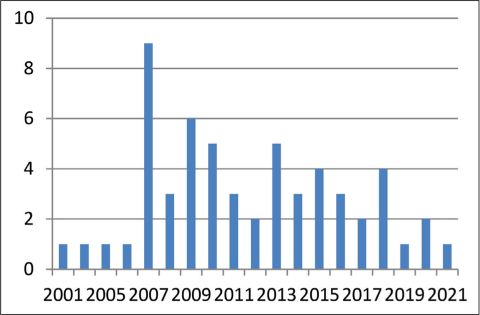
Explanation: In Figure 4, it is highlighted that all the 57 documents are open access which are available as full text. The blank indicates that there were documents with undefined open-access type. The above data show the count of years in which publication of article occurred. Figure 2 consists of 20 different years, starting from 2001 and ending in 2021, and the corresponding count of occurrences for each year. The highest count of occurrences was in 2007, with a total of nine publications, while the lowest was in 2001, 2002, 2019 and 2021, each having only one publication. The total number of publications recorded for all the years is 57.
Figure 3 shows a breakdown of the document types and their corresponding counts in a collection of 57 documents. The four types of documents identified in the data are articles, book chapters, conference papers and reviews. Out of the 57 documents, articles were the most common type, with a total count of 32. Conference papers came in second place, with 17 instances, followed by book chapters and reviews, with counts of 4 each.
Figure 3. Document Type.

Figure 4. Open Access Type.

Figure 5 shows the subject area with the highest count among the subject area is Business, Management and Accounting with a total of 38 documents. Following that, computer science has 14 documents, while engineering has only one document. Multidisciplinary and social sciences both have two documents each. In total, there are 57 documents across all subject areas. This information suggests that there is a greater emphasis on business, management and accounting than other fields, such as computer science and engineering. It is important to note, however, that these data may not reflect the entire range of subjects offered in academic institutions or other settings, as it is based on a limited sample.
Figure 5. Subject Area.
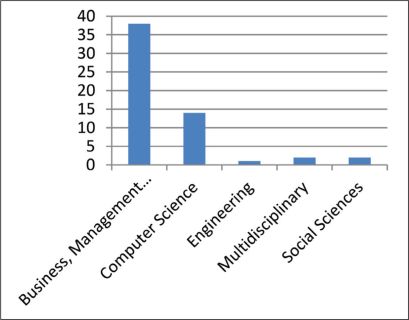
Source: Scopus.
Objective 3: To provide insights into the productivity and collaboration patterns of researchers, documents, keywords and countries.
Studying the productivity and collaboration patterns of researchers is crucial to understanding the dynamics of academic research. To gain insights into these patterns, one can analyse various factors such as the number of documents produced by researchers, the keywords they use in their work and the countries they are affiliated with. By examining these factors, researchers and institutions can identify trends and areas of collaboration and make informed decisions about how to allocate resources and support ongoing research efforts. Ultimately, understanding the productivity and collaboration patterns of researchers is essential for driving innovation and advancing knowledge in a wide range of fields.
Figure 6 presents the frequency of occurrence and total link strength for various keywords. HRIS is the most frequently occurring keyword, with 12 occurrences and total link strength of 14. HRIS and HRM both have 10 occurrences, with total link strengths of 16 and 18, respectively. Adoption, information systems and IT have 3–5 occurrences and total link strengths of 6–12. e-HRM, HRIS adoption, HRIS applications, HRIS, social influence, technology acceptance model, technology adoption and user satisfaction all have 2–3 occurrences and total link strengths of 1–7. Jordan and organisational performance have two occurrences each, while is implementation has two occurrences and a total link strength of one. Finally, HRIS has two occurrences and total link strength of three.
Figure 6. Co-occurrence of All Keywords.
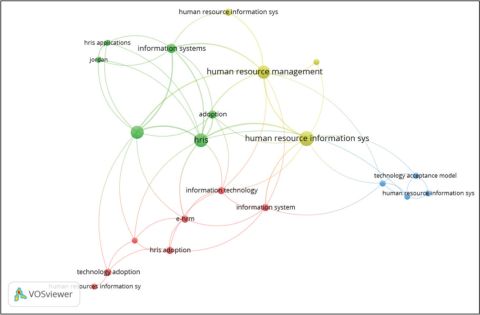
Figure 7. Co-authorship of Countries.

Figure 4 displays the number of documents, citations and total link strength for various countries. The United Kingdom has the highest number of documents (7) and citations (313), with total link strength of 3. Jordan comes in second with 6 documents and 49 citations, followed by Malaysia and Saudi Arabia with 3 documents and 14 citations each. The United States has 7 documents and 248 citations but has lower total link strength of 1. Australia has 2 documents and 52 citations, while China, Germany, India, Indonesia, Kuwait, the Netherlands and South Africa have 2–10 documents and up to 55 citations, but none of them has any total link strength.
The data presented in Figure 8 show the count of countries included in the dataset. Among the 55 countries, the United States has the highest number of publications, with a total of 9. This is followed by India, with 6 publications and the United Kingdom with 7. China and Malaysia each have four publications, while there are two publications each from Australia, Indonesia, Jordan, Saudi Arabia, South Africa and Thailand. There is one publication each from Bangladesh, Brazil, Germany, Hong Kong, Iraq, Italy, Kuwait, Pakistan, Singapore, Spain, Turkey, United Arab Emirates and undefined (State). It is worth noting that there is a blank entry, which indicates undefined. Overall, the information provides insight into the geographic distribution of publication of articles on HRIS especially in service sector, indicating a diverse range of countries represented in the dataset.
Figure 8. Publication by Country.
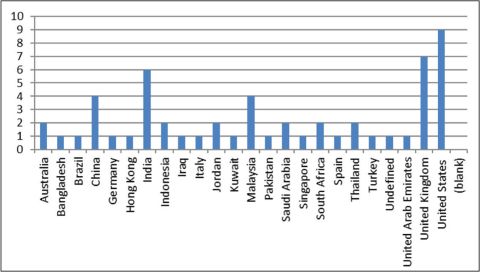
Discussion
HRIS is the most frequently occurring keyword that can be read in most of the articles and can be concluded that it has brought about positive changes in the competitive edge and management practices of an organisation. Besides enhancing the functioning of the HR department, it has transformed the gathering of important data and its transformation into information that can enhance the quality of decision-making. Furthermore, HRIS has ensured the prompt delivery of HR services, which leads to employee satisfaction. Along with HRIS HRM, adoption, information systems and IT are mostly occurring keywords highlighted in Ngai and Wat (2006), Hussain et al. (2007), Al-Dmour and Al-Zu’bi (2014) and Lippert and Swiercz (2005).
For an organisation to achieve its goals and objectives, operate efficiently and attain success, it is crucial to adopt IT (Tuteja et al., 2019). The collection of articles reviewed in this analysis provides insight into the impact of HRIS on organisations. The findings show that most HR practices influence the adoption and implementation of HRIS in service sectors, where the HR department regards HRIS as a vital tool to enhance their value and improve internal processes. Additionally, management commitment, human capability and regulatory compliance are essential factors that drive the success of HRIS adoption. The use of HRIS in organisations leads to greater efficiency, reduced repetitive work and lower management costs. However, insufficient financial support, lack of IT expertise and limited commitment from top management are significant barriers to HRIS implementation. The data also highlight a greater emphasis on business, management and accounting than other subject areas. Ultimately, organisations that can implement HRIS cheaper and faster while obtaining an application that better suit their needs tend to outperform IT suppliers. These insights provide a comprehensive understanding of the role and impact of HRIS in organisations, highlighting the need for strategic management and effective adoption practices to improve efficiency and performance.
Conclusion
The study examines human resource technology, that is, HRIS that can enhance human resource practices and improve its productivity and performance in service sectors. The use of computer systems and information technologies in service sectors can provide numerous benefits, including cost reduction, time-saving and reducing work stress. An HRIS should be capable of collecting typical HR information and providing analysis of these data. This can assist a service sector in effectively implementing its human resource plans.
Limitations of the Study
The study’s shortcomings are mostly reflective of the inadequacies in the reports evaluated. The information used in this study was confined to articles, conference papers, book chapters and review articles published in Scopus database only. The research is based on an existing HRIS scenario, which may not be able to keep up with rapid technological advancements. There is a probability that we have missed some studies that were beyond our accessibility. Another limitation is that the records are limited to the publication year 2001–2021, articles published before 2001 were accessible online but the online analytical processing was electronically poor. Relevant studies may have been ignored since most of the research on the topic of HRIS was found to be distributed across several disciplines while scanning the related studies. The study area is confined to the service sector only which does not highlight the implication of other areas.
Declaration of Conflicting Interests
The authors declared no potential conflicts of interest with respect to the research, authorship and/or publication of this article.
Funding
The authors received no financial support for the research, authorship and/or publication of this article.
ORCID iD
Moneswari Boro  https://orcid.org/0000-0002-8029-7339
https://orcid.org/0000-0002-8029-7339
Al-Dmour, R. H. (2020). The influence of HRIS usage on employee performance and mediating effects of employee engagement in five stars hotels in Jordan. International Journal of Information Systems in the Service Sector, 12(3), 118.
Al-Dmour, R. H., & Al-Zubi, M. F. (2014). Factors motivating and inhibiting the practice of HRIS in business organizations: An empirical analysis. International Business Research, 7(7), 139.
Al-Khowaiter, W. A. A., Dwivedi, Y. K., & Williams, M. D. (2014). Examining the role of social influence, usefulness and ease of use for determining the mandatory use of a human resource information system in the context of Saudi ministries. International Journal of Electronic Government Research, 11(3), 2442.
Alleyne, C., Kakabadse, A., & Kakabadse, N. (2007). Using the HR intranet: An exploratory analysis of its impact on managerial satisfaction with the HR function. Personnel Review, 36(2), 295310.
Bhosale, U. (2022). 7 steps of writing an excellent academic book chapter. Enago Academy Blog.
Burbach, R. A., & Dundon, T. (2005). The strategic potential of human resource information systems: Evidence from the Republic of Ireland. Intentional Employment Relations Review, 11, 97117.
Chugh, R. (2014). Role of human resource information systems in an educational organization. Journal of Advanced Management Science, 2 (1), 149153.
Comparehris.com. (2012). Top 4 reasons you need an HRIS. https://www.comparehris.com/blog/top-4-reasons-hris/
Dixon, T., Thompson, B., & McAllister, P. (2002). The value of ICT for SMEs in the UK: A critical review of literature. Report for the small business service research programme. The College of Estate Management.
Eck, N. J. Van., & Waltman, L. (2009). How to normalize co-occurrence data An analysis of some well-known similarity measures. Journal of the American Society for Information Science and Technology, 60(8), 16351651.
Emilio, A. S. (2007). Testing resource-based propositions about IS sourcing decisions. Industrial Management & Data Systems, 107(6), 762779.
Garfield, E. (1979). Is citation analysis a legitimate evaluation tool Scientometrics, 1(4), 359375.
Hussain, Z., Wallace, J., & Cornelius, N. E. (2007). The use and impact of human resource information system on human resource management professionals. Information & Management, 44, 7489.
Kavanagh, M. J., & Thite, M. (2009). Human resource information systems: Basics, applications, and future directions (pp. 630). Sage Publications.
Kovach, K. A., & Cathcart, C. E. (1999). Human resource information systems (HRIS): Providing business with rapid data access, information exchange and strategic advantage. Public Personnel Management, 28(2), 275282.
Kovach, K. A., Hughes, A. A., Fagan, P., & Maggitti, P. G. (2002). Administrative and strategic advantages of HRIS. Employment Relations Today, 29(2), 4348.
Kirishna, R., & Meena, J. (2010). Usage of ICT for information administration in higher education institutions: A study. International Journal of Environmental Science and Development, 1(3), 282286.
Krishnan, S., & Singh, M. (2006). Issues and concerns in the implementation and maintenance of HRIS. Issues and concerns in the implementation and Indian Institute of Management Ahmedabad. Research and publication department in its series IIMA working papers with number WP2006-07-01.
Lengnick-Hall, M. L., & Moritz, S. (2003). The impact of e-HR on the human resource management function. Journal of Labor Research, 24(3), 365379.
Lippert, S. K., & Swiercz, P. M. (2005). Human resource information systems (HRIS) and technology trust. Journal of Information Science, 31(5), 340353.
Martinson, M. G. (1994). Benchmarking human resource information systems in Canada and Hong Kong. Information & Management, 26, 305316.
Mathis, R. L., & Jackson, J. H. (2010). Human resource management (13th ed.). South-Western College Pub.
Moher, D., Liberati, A., Tetzlaff, J., & Altman, D. G. (2010). Preferred reporting items for systematic reviews and meta-analyses: The PRISMA statement. International Journal of Surgery, 8, 336341.
Mother, D., Liberati, A., Tetzlaff, J., & Altman, D. G. (2010). Preferred reporting items for systematic reviews and meta-analyses: The PRISMA statement. International Journal of Surgery, 8, 336341.
Ngai, E. W. T., & Wat, F. K. T. (2006). Human resource information systems: A review & empirical analysis. Personnel Review, 35(3), 297314.
Phahlane, M. M., & Kekwaletswe, R. M. (2019). A conceptual research framework for human resource information systems adoption and use in universities. In Conference on information communications technology and society.
Poon, S., & Swatman, P. M. C. (1999). A longitudinal study of expectations in small business internet commerce. International Journal of Electronic Commerce, 3, 2133.
Rawat, M. (2008, 1517 December). Application of human resource information system (HRIS) in higher education: Holistic approach. In Trusting Islam, knowledge and professionalism in ECER development conference, Kota Bharu, Malaysia.
Rene (2021). Publishing research as book chapters: Is it worth it PRS Blog.
Strohmeier, S. (2007) Research in e-HRM: Review and implications. Human Resource Management Review, 17, 1937.
Tannenbaum, S. I. (1990). HRIS: User group implications. Journal of Systems Management, 41(1), 2732.
Tansley, C., & Newell, S. (2010). A knowledge-based view of agenda-formation in the development of human resource information systems. Management Learning, 38(1), 95119.
Tranfield, D., Denyer, D., & Smart, P. (2003). Towards a methodology for developing evidence: Informed management knowledge by means of systematic review. British Journal of Management, 14, 207222.
Troshani, I., Jerram, C., & Hill, S. R. (2011). Exploring the public sector adoption of HRIS. Industrial Management & Data Systems, 111, 470488.
Tuteja, S., Hyde, A. M., & Sharda, P. (2019). Factors affecting adaptation of information technology among nationalized and private bank employees. International Journal of Innovative Technology and Exploring Engineering, 8(8), 19701975.
Volkmer, I. (1999). News in the global sphere: A study of CNN and its impact on global communication. University of Luton Press.
Wiblen, S., Dery, K., & Grant, D. (2010). Transitioning to a new HRIS: The reshaping of human resources and information technology talent. Journal of Electronic Commerce Research, 11(4), 251267.
Ying, G., Bin, T., & Xiao-hui, G. (2009). J2EE-based human resources management information system design and implementation. In Proceedings of the 2009 WRI World Congress on Computer Science and Information Engineering, 2528.
Websites Accessed